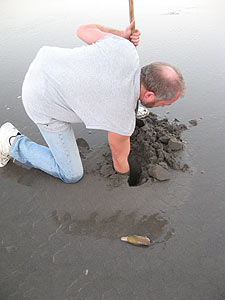 |
Oregon Wildlife Officials Offer Tips for January on the Coast
Published 01/05/2012

(Oregon Coast) – Oregon Department of Fish and Wildlife (ODFW) recently released another recreation report, which offered some tips on crabbing, minus tides and even whales (above: low tide at Cape Kiwanda, Pacific City).
There are some more minus tides January 7 through 12, starting in the early evening. But more significant minus tides happen starting January 20, sometimes as low as minus nine or ten inches.
 |
| Clamming in Seaside |
These should be prime conditions for razor clamming, barring any large storm conditions. ODFW said razor clamming is good on the beaches between Cannon Beach and Warrenton – which includes Seaside and Gearhart.
But tidal conditions will have to be examined.
“Look for a minus tide and combined wave heights of less than 10 feet,” ODFW said. “An east wind will help knock down the swell; likewise a southwest wind will make surf conditions worse for clamming. This time of year many good clam tides occur after dark, so make sure you keep a wary eye on the ocean. Never turn your back on the ocean when clamming.”
ODFW said shellfish harvesting is open pretty much along the entire Oregon coast, including mussels. Scallops, however, are not recommended for catching now because of some toxin closures.
Crabbing has been quite good, especially in the bays. ODFW said large males were filling out nicely, with some great catches in the lower Columbia River and Alsea Bay.
Whales are still catchable along the Oregon coast, even though the peak migration period has ended. They are still moving past these waters through the first two weeks of January.
 |
| Whale photo courtesy Whale Watch Center, Depoe Bay |
“A gray whale's blow is up to 15 feet high, and each blow is visible for about five seconds,” ODFW said. “When warm, moist air exhaled from the animals' lungs, meets the cool air at the ocean surface, it creates the bushy column called a blow, or spout. Anticipate that the whale will dive for three to six minutes, then surface for three to five blows in row, 30 to 50 seconds apart, before diving deep for three to six minutes again.”
ODFW suggests finding a calm day and a high viewpoint, such as Neahkahnie Mountain near Manzanita, Cape Foulweather near Depoe Bay, Ecola State Park at Cannon Beach or the Cape Perpetua Visitors Center near Yachats – to name a few. You'll want to look out a few miles beyond shore.
“Learning good binocular technique will help spot the whales,” ODFW said. “Gaze out onto the ocean, focusing on medium distances until you see a puff of white. Then raise your binoculars while continuing to look at the place you saw the puff. This technique takes some practice, but generally works better than swinging the binoculars around looking for something. Just keep your eyes focused on the whale and raise the binoculars to your eyes, looking through them, not into them.”


Newport's Yaquina Bay
More About Oregon Coast hotels, lodging.....
More About Oregon Coast Restaurants, Dining.....
 |
 |
 |
LATEST OREGON COAST NEWS STORIES
Whale Body Parts Found on Oregon Coast - Two Whales Strand on Washington Coast |
Back to Oregon Coast
Contact Advertise on BeachConnection.net
Secrets of the Season |
Unusual Travel Articles TravelParanormal.com allows you to submit your own creepy tale or debunk one - or see up-to-the-minute news headlines about travel and the paranormal. News Headlines from All Over Oregon Need to scan Oregon headlines? Constantly updated news from all over Oregon: a comprehensive, up-to-the-minute display of news headlines from a variety of media |




































